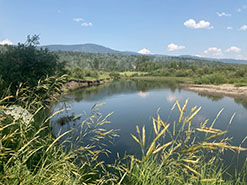Horsefly River Riparian Area

Horsefly River Riparian Area. Photo by Tara Salm
Winding down from the Cariboo Mountains, the Horsefly River is one of the most important salmon spawning and rearing waterways in the province. Each year, the salmon fight their way up the roaring Fraser and Quesnel Rivers to the Horsefly River’s natural spawning beds.
Loss of riparian areas along this river threaten the continued health and vitality of this river system and the salmon populations that rely on it. Logging and conversion for agriculture have impacted about 40 per cent of the river’s riparian habitat.
The Nature Conservancy of Canada’s (NCC’s) Horsefly River Riparian Conservation Area protects 389 hectares along the river, including 12 kilometres of shoreline. The conservation area consists of abundant riparian areas, lined with broadleaf forests of black cottonwood and quaking aspen. About a third of these trees are old-growth. The section of river within the conservation area is used for spawning and rearing by sockeye, chinook and coho salmon and a distinct strain of rainbow trout that is recognized as the second-largest strain of this species in the world.
Grizzly bears, which are listed both nationally and provincially as a species at risk, and black bears frequent the watershed. Moose find exceptional winter habitat here. A wide range of songbirds, waterfowl and wading birds also utilize the wide valley bottom.
Portions of the conservation area were historically converted for agricultural purposes, and some of this land continues to be used for haying and cattle grazing. NCC is managing the conservation area to balance these uses with its conservation needs, including installing wildlife-friendly fencing to keep cattle out of riparian and other sensitive areas, and managing invasive species.
This land had long been of value to conservation interests for its valuable fish and wildlife habitat. Formerly part of the historic Black Creek Ranch, the land was first conserved 1999. In 2015, NCC assumed ownership and management of Horsefly River Riparian Conservation Area as part of the transfer of 26 properties from The Land Conservancy (TLC) in order to ensure their long-term protection. These property transfers were made possible with the assistance of the Government of Canada’s Natural Areas Conservation Program, the Province of British Columbia and the Fish and Wildlife Compensation Program.





